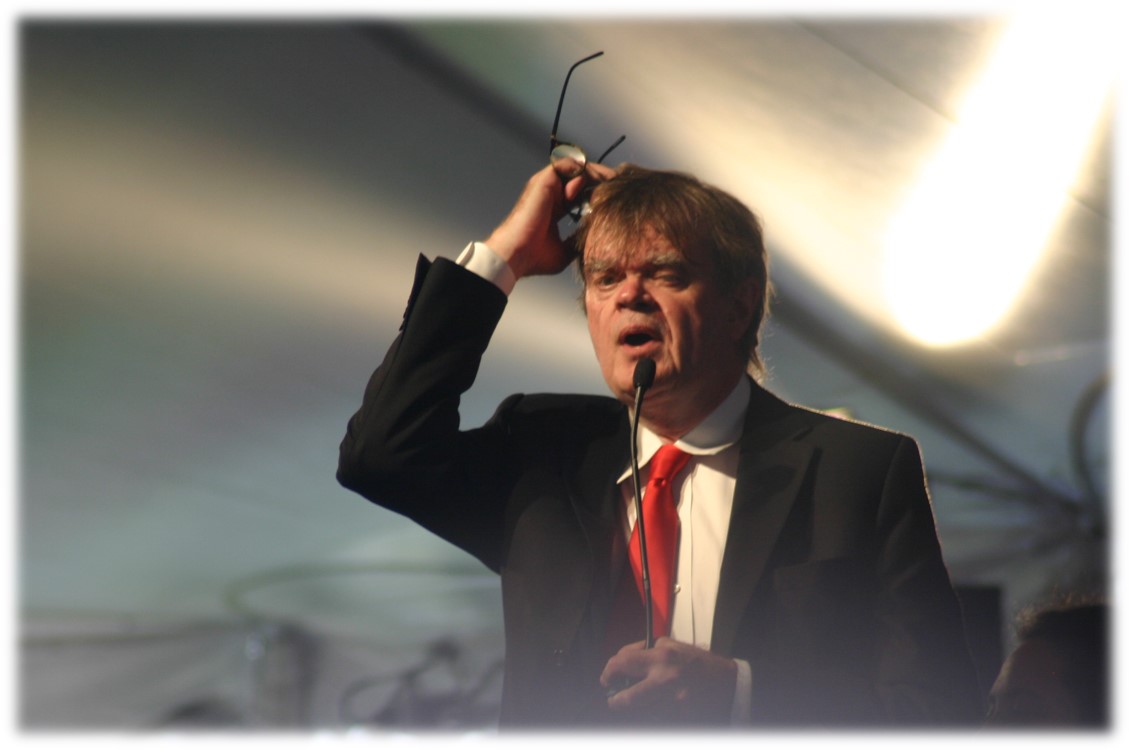
These days, there’s a lot of buzz and noise about the future of public radio. In recent articles in both The Wall Street Journal and The New York Times, the efficacy of the system’s radio programming along with the raison d’être of public radio in general is being questioned.
At the epicenter of this is Garrison Keillor, enigmatic host of A Prairie Home Companion. If you’ve somehow avoided listening to his program about the news from fictitious Lake Wobegone, you’ve missed an amazing slice of Americana – and certainly a unique form of radio that simply cannot be heard anywhere else – on commercial or public radio, or even in those podcasts that everyone is rushing to produce.
And yet, over the past several years, the inevitability of Keillor’s retirement has shifted from being an event like an asteroid hitting the earth (“Where will we be without Garrison Keillor?) to the gleeful end of the dinosaur era. For many, A Prairie Home Companion represents all that is tired, dated, and yes, old about public radio. Even inside the system, many can’t wait for him to hang up his headphones so that the weekend lineup can be revitalized. But by what?
That thinking also misses the larger point behind this moment in time. The significance of Keillor sailing off into the public radio sunset underscores the innovation gap left behind by one of the true creative giants of the medium.
Instead, the conventional thinking is that if networks like NPR, PRI, and APM (which produces PHC) are to grow and adapt and appeal to Millennials, it must move on from old war horses like Keillor and Car Talk – two shows that at one time symbolized public radio’s inventiveness, but have now been overshadowed by new shows that are focused on trivia and storytelling.
Car Talk continues in a surreal post-produced netherworld where past programs are deftly edited to sound reasonably contemporary, despite the death of Tom Magliozzi back in 2014. And in Keillor’s case, he has already named his successor: 35 year-old Chris Thile, who takes over PHC in October.
While many public radio execs wonder whether PHC will the go the route of The Daily Show without Jon Stewart, the larger question is where the next truly innovative program or concept will come from.
In the New York Times article by Cara Buckley, some of Keillor’s true contributions to public radio are highlighted, reminding readers just how innovative his show was, and how it indelibly impacted the medium. Keillor forged a sense of celebrity and personality to public radio at a time when it was essentially faceless. And the live touring aspect of PHC brought the show to thousands of radio listeners, paving the way for shows like The Moth Radio Hour and Wait Wait, Don’t Tell Me! to do the same.
And while ratings for PHC have slid over the last decade and demographics have skewed older, the show expanded the public radio audience, creating a bigger tent. As importantly, it generated buzz, a concept antithetical to the early days of the public radio system.
It’s not about who will replace Garrison Keillor – it is about who can capture that raw spirit of innovation and invention he imbued in his quirky, offbeat radio creation.
In talking about the success of the show to The Times, Keillor noted that he was heavily influenced by covering the Grand Ole Opry when he was a reporter for The New Yorker in 1974. Months later, PHC was born, and Keillor quickly realized he had added something unique to the medium:
“With radio, I owned it. I owned it. Nobody else was doing this. You find yourself on new ground, and you are so free. You are so free.”
There’s no question that the Magliozzi brothers (“Click and Clack”), Howard Stern, and Rush Limbaugh must have felt a similar torrent of enthusiasm and excitement at about the same point in their career arcs, too.
The challenge is to rekindle that feeling again. For public radio (and commercial radio, too), it’s been awhile. This American Life debuted in 1995, Wait Wait first aired in ’98, and The Moth turns 7 years-old in August.
Perhaps the most recent public radio innovation wasn’t a show at all, but a podcast. Serial is the poster child representing the potential for on-demand audio to go mainstream, capturing buzz, attention, and sponsor dollars. Of course, podcasts aren’t new, and there have been hundreds of thousands of them floating around the Internet before Serial burst on the scene in late 2014.
Its “secret sauce” was that it didn’t sound like other podcasts. Serial had a beginning, middle, and an end rather than continuing on indefinitely (or until either the producers or the audience loses interest) like most podcasts do.
And that’s the real challenge facing public radio – and all of radio – at this inflection point. It’s not whether the new PHC can hold Keillor’s ratings, whether Millennials will stop Snapchatting and Spotifying long enough to discover public radio content, or who the next host of The Diane Rehm Show will be.

It’s a question about the freedom to innovate in an environment where the pressures and stakes are rising every day. General Electric CEO Beth Comstock knows a little something about inspiring legacy brands to be more creative. She says the key to engendering new ideas and thinking can be summed up in two words: Permission granted.
In most business organizations today – including media companies and brands – this is often easier said than done. There are many competing and negative forces arguing for the status quo, and against the true spirit of trying something different.
I see this consistently during “format search” exercises in radio where expensive research studies are commissioned to determine the direction for a struggling station. Inevitably, broadcasters end up choosing so-called tried and true formats because new and previously unheard of concepts rarely pass muster the first time around. Thus, new ground is rarely broken, and we end up with a status quo format. Trust me when I tell you as an experienced researcher that Car Talk, Howard Stern, and This American Life would not have tested in focus groups or a perceptual study before they actually aired. Keillor’s concept would never have seen the light of day.
That’s because the next big thing never sounds like the last big thing.
It takes stones to encourage a spirit of true innovation in a corporate environment that says it craves new and different but is rarely ready to truly commit to seismic change. And it’s not just about the corner office. The “Permission granted” seal of approval can’t just come from Jarl Mohn, Jon McTaggart, and other network CEOs. It needs to be part of the mindset of program directors throughout the system, committing to a spirit of openness to new ideas and content innovation.
What’s past is prologue. Experience clearly tells us that if radio – public or commercial – is to survive and thrive in this heated, overcrowded landscape, a summer vacation to a place called Lake Wobegon wouldn’t be a bad place to start.
Public radio will miss Garrison Keillor’s spirit more than it can imagine.

- What To Do If Your Radio Station Goes Through A Midlife Crisis - April 25, 2025
- A 2020 Lesson?It Could All Be Gone In A Flash - April 24, 2025
- How AI Can Give Radio Personalities More…PERSONALITY - April 23, 2025




Let’s hear it for PG – Permission Granted! All it took to connect was one pro and a microphone, if it was handled by Ronald Reagan, Curt Gowdy, Gene Shepherd, FDR, Walter Cronkite and the All-Time Radio Class. Fear of flying, CYA and some folks in charge needing a flashlight to see what’s going on has caught up. Thought for the week: It’s not Millennials vs. Boomers nor commercial or non-commercial. It’s all about Best Show Wins. Plenty of cross-over and, great ideas don’t cost. New, different and mass appeal needs a time, place, culture and channel to nurture and curate connected presentation. And, we need it now! Thanks, Fred. See you at NJBA, in Atlantic City, this week. Clark http://www.broadcastideas.com
We’re on the same page – regardless of platforms, demographics, and anything else, the best show wins. Thanks, Clark. See you in NJ.
Great column. GK was more of a visionary than people who write about his retirement give him credit for. They write that his show was “old-timey” because he admitted being inspired by the Grand Ole Opry and because it never swore, and now it HAS to be “old-fashioned” because it’s literally old. But you could also argue that his show was cutting edge. The program was about 4 or 5 main things that, depending on how you looked at it, either merely continued tried and true entertainment formulas during his run, or expanded and refined those genres, inspiring other practitioners for 4 decades in an important way.
1) Storytelling. This American Life, The Moth, Snap Judgment, NPR Feature Reporting, or even Serial, all frankly pick up a lot from how a tale from Lake Wobegone reels a listener in, keeps them tangled in the line for awhile, then successfully cuts them loose with something worth taking home.
2) Observational Comedy. GK does it great. Particularly around relationships. Seinfeld, Roseanne, Chris Rock, Louis C.K., Gaffigan, Aziz Ansarri, dozens of others continued in their own way, in their stand-ups, then acting it out in our most important sitcoms.
3) Political Satire. Always included in PHC, in sometimes biting honesty. Daily Show, Colbert, Nightly Show, Sam Bee, Oliver make it their raison d’etre.
4) Commercial parodies. A mainstay of comedy for the last 40 years with SNL running with it more than anyone… but it was always a part of GK’s schtick.
5) Americana Music. Now with a chart of its own from Billboard and a good number of pub radio stations devoted to it. The parade of artists from that genre who were always welcome on PHC is significant.
Paul, great observations all. So many radio and TV stars and shows have been inspired by Keillor, and not just in the public radio sector. Thanks for connecting the dots for us, and for reading our blog.
Public Radio Needs Garrison KeilIor? I need Garrison Keillor! I adore hearing the particular cadence in his voice sharing stories from Lake Wobegon. No one can replace him nor should they even try. He is such a wonderful communicator and storyteller. He painted the picture with only words as his brush. I’ve seen him live and I feel like I know some of these people he talks about and to. He makes a connection. I received a call from a listener last week who listened to me on the air when I did the Quiet Storm Show in Toledo. He said “You know when you left I have never heard anyone before or since who did a show like you did.” He listened most nights and he actually remembered phone calls and some of my 10:10 poetry and things I said!? Sadly I don’t see a want or a need for that kind of connection anymore. If there was there would be people like me out there doing it. But radios needs have changed ever since they started treating it more like a bank. I see and hear it from radio friends across the country that there is no money invested in talent anymore. If someone does indeed attempt to “replace” him I’m guessing it will be on the internet and not monetized. I believe the seasoned and unseasoned talent have plenty of creative ideas that could work and be monetized but they never see the light of day. It will be interesting to see how this all plays out…enjoyed your story very much. ps just read that Keillor’s replacement will be Chris Thile, a mandolinist and singer in the bands Punch Brothers and Nickel Creek. Thile guest-hosted two APHC shows in February. Thile, reportedly said, “Everything Garrison said is true, and I’m really excited.” We shall see…
Kim, thanks for the personal story about Garrison Keillor & the power of PHC and Lake Wobegon. Many people working in radio were inspired by Keillor’s creativity and imagination. As for your comments that there’s no place in radio for that personal connection, I would humbly suggest you’re talking to the wrong broadcasters. This type of radio may be a rarer commodity than it once was, but its value has never been more important. Thanks for weighing in and reading our blog.